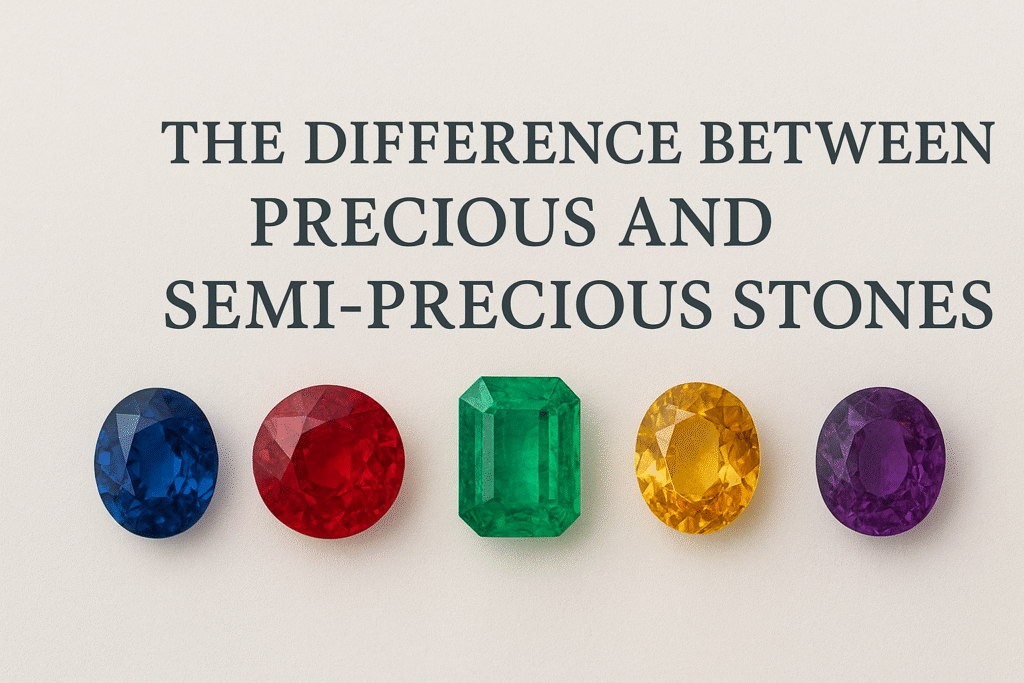Walk into any jewelry store or gem market, and you’ll hear two terms often used – precious stones and semi-precious stones.
But what exactly makes one “precious” and the other “semi-precious”?
The truth is – the difference isn’t just about beauty. It’s about rarity, history, and value. Let’s uncover how gemologists actually classify these dazzling treasures.
Table of Contents
💍 1. A Historical Distinction – Not Just Marketing
The classification of gemstones into “precious” and “semi-precious” dates back centuries.
In ancient times, people recognized only four stones as truly precious:
- Diamond
- Ruby
- Emerald
- Sapphire
These gems were treasured by royalty, worn in crowns, and traded as symbols of wealth and power.
Every other stone – from amethyst to topaz – was labeled semi-precious.
But in today’s gemology, this term is scientifically outdated.
🧠 2. What Modern Gemology Says
Gemologists no longer rely on the “precious vs. semi-precious” classification.
Instead, they evaluate gemstones based on four key factors:
- Rarity – How difficult it is to find the stone in nature
- Quality – The cut, clarity, and color of the gem
- Durability – How resistant it is to scratching and wear (Mohs scale)
- Market Value – Demand, origin, and cultural significance
That means some “semi-precious” gems – like Alexandrite, Tanzanite, or Paraiba Tourmaline – can actually be more valuable than traditional “precious” stones.

💰 3. Precious Stones: The Elite Four
Let’s look at what makes these four stones so exclusive:
💎 Diamond
The hardest natural substance on Earth. Valued for brilliance, fire, and purity.
❤️ Ruby
A red variety of corundum. “Pigeon blood” rubies from Burma are among the rarest gems ever discovered.
💚 Emerald
Known for its deep green hue. Flawless emeralds are far rarer than flawless diamonds.
🔷 Sapphire
Comes in many colors, but the blue sapphire remains the most sought after – symbolizing wisdom and protection.
Each of these stones holds deep symbolism and investment value, which is why they maintain their “precious” reputation even today.
💠 4. Semi-Precious Stones: Beauty Beyond Labels
The term “semi-precious” covers hundreds of gemstones – from colorful quartz to exotic minerals.
Examples include:
- Amethyst (Purple Quartz)
- Citrine (Golden Quartz)
- Garnet
- Topaz
- Peridot
- Aquamarine
- Tourmaline
Though more common than diamonds or rubies, these stones are celebrated for their unique colors and energies.
They’re also more affordable, making them perfect for everyday jewelry or healing purposes.
🌈 5. Value Doesn’t Always Equal Energy
Interestingly, a gem’s spiritual energy doesn’t depend on its market price.
For instance:
- Amethyst, a semi-precious stone, is known for powerful calming energy.
- Citrine attracts wealth and optimism.
- Lapis Lazuli promotes clarity and truth.
So while the “precious” label might determine market value, the vibrational value of each gemstone is truly personal.
🧾 6. Certification Matters – Not the Label
Whether precious or semi-precious, what truly determines a gemstone’s authenticity is its certification.
A gem lab certificate reveals:
- Natural vs synthetic origin
- Presence of treatments
- Color, clarity, and cut grading
Before buying, always ask for a certified gemstone from a trusted gemological lab (like GIA, IGI, or GemLabTesting).
That’s the only way to ensure your gem is genuine – not just labeled.
✨ Final Thought: All Gems Are Precious in Their Own Way
The world of gemstones is vast and colorful.
While some shine with royal history, others glow with spiritual warmth and natural charm.
Whether it’s a diamond or a garnet, what truly makes a gemstone precious is its connection to you – the story it tells, and the energy it carries.